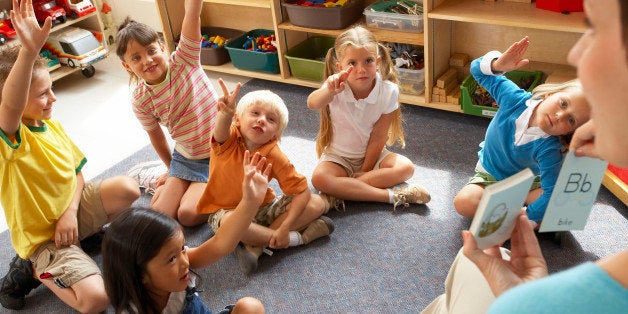
Improving education is a complex task that will require new ways of thinking to take us beyond our current beliefs about reform. Mandating change through federal legislation, force-fitting a common curriculum to all schools and students and focusing on weeding out bad teachers are all examples of solutions on which we have spent a great deal of money and energy. While these may seem sensible at first glance, they haven't worked well so far, and are unlikely to ever bring about lasting and meaningful improvement.
Stanford University professor Larry Cuban explained why this is the case, noting on his blog ,last summer that reforming education is very different than something like putting a person on the moon where each step can be precisely engineered. While moon landings and similar ventures are extremely complicated, Cuban argued that education and other social endeavors, like criminal justice and health care, are complex, filled with "hundreds of moving parts, scores of players of varied expertise and independence, yet missing a 'mission control' that runs all these different parts within an ever-changing political, economic and societal environment." One of Cuban's main points is that in complex systems, efforts to impose significant change by imposing rules from the top will "hardly make a dent in the daily work of those whose job is convert policy into action."
When it comes to systems, the difference between complex and complicated is decidedly not just semantics. It's a hallmark of complex systems that centralized "mission control" strategies don't work and simple cause-and-effect thinking doesn't apply. Understanding education as a complex system means letting go of our attachment to cause-and-effect solutions (especially the so-called "silver bullets") in order to bring about improvements that last and have a meaningful impact on students and their learning.
So what's different when we start to understand education as a complex system? Slime molds are an interesting example of a complex system from nature and (despite the unappealing associations of both slime and mold) may provide an insight or two into how we might think about education differently. Slime molds behave as a colony of individual, single-celled organisms until food supplies run low; then the colony acts a single, complex organism that moves off to find a new food source. For many years, scientists assumed that there must be a special kind of slime mold cell (called a pacemaker cell) that effectively ordered all the other cells in the colony to form up and move out. The fact that no one could actually find a pacemaker cell didn't do much to disrupt that theory.
Then in 1970, Evelyn Fox Keller and Lee Siegel found that each individual slime mold cell secreted a type of pheromone when food was sparse. Other slime mold cells follow those pheromone trails, leading to a clumping of cells in areas with sparse food. Those cells, in turn, secrete pheromones that attract more cells, which also secrete pheromones -- and so on. It turns out that there were no pacemaker cells at all. The actions of the slime mold colony as a whole come about as a pattern that emerges from the relatively simple rules that govern how one cell reacts to another.
What may look like centralized control (a few pacemaker cells ordering the colony to pack up and move) is really an emergent pattern. In fact, this is another hallmark of complex systems -- patterns emerge from relatively simple interactions between the agents in the system. Slime mold cells follow pheromone tracks left by other slime mold cells who have detected a dearth of food, and a pattern of whole-colony movement emerges. But the idea of centralized control holds a very strong appeal for us -- our initial reaction is often to seek (or impose) some person or group of people (or agents, like pacemaker cells) who are making things happen, probably intentionally.
On the surface, the U.S. education system might appear to be highly centralized; classrooms are led by teachers, schools are led by principals, districts are led by superintendents and so on. When we identify troubling patterns in education, we tend to make simple cause-and-effect assumptions about what is causing those patterns, often by looking for someone, or some group, to blame for the problem. For example, if students aren't scoring well on achievement tests, we assume that it must be because their teachers aren't doing a good job, so we implement policies that punish or reward teachers based on student test scores. The fact that these simple cause-and-effect solutions don't work doesn't seem to dissuade us from coming up with new ones, often at great expense.
These solutions don't work because the education system is complex, and nested within the larger system are other complex systems like districts, schools and classrooms. The "agents" within the system (e.g., students, teachers, administrators, parents, school board members, policy makers, etc.) interact in a web of relationships that shape how the system performs. These interactions produce the patterns that we see, both good and bad. But -- and this is critical -- this does not mean a particular agent is causing a pattern. Our tendency to look for centralized control and simple cause-and-effect explanations in the education system is actually hampering our efforts to bring about meaningful and lasting change.
To bring about change in complex systems like education, we need to look beyond centralized top-down approaches with limited impact in schools and classrooms. Recently, political and education leaders and experts on teaching have paid increasing attention to the current and potential role of teacher leaders and what it might take to develop them. Developing teacher leadership capacity is a major focus of the Knowles Science Teaching Foundation, where I work. As such, we spend a lot of time thinking about what leadership, particularly, teacher leadership means in a complex system like education.
The work of theorists who apply complexity theory to leadership in organizations provides some useful insights for understanding leadership in education. The first is that leadership can be best understood as an event, rather than the actions of an individual. Specifically, leadership is an event in which knowledge and behaviors change in ways that make the system more adaptive to the constantly evolving pressures of the political, social and economic environment. When viewed this way, leadership is something that can and does happen at all levels of the education system. But this does not mean that there are no leaders in complex systems. Rather, leaders in complex systems help create and foster the conditions for leadership events, but they don't cause them. Just as leadership events can occur at all levels of the organization, leaders can be found and developed at all levels.
These ideas fit nicely with the call for teacher leadership and the idea that teachers can and should be the ones responsible for improving education. But we need to be careful. If we expect teacher leaders to "cause" a change in the system because of their special status, role or, skills, we are just imposing an assumption of centralized control at a different level of the system and will be unlikely to see real improvement. In other words, if we expect teacher leaders to be the pacemaker cells which will bring about major change in the education system, we are going to be disappointed.
Rather, we need to cultivate the capacity within teachers -- and ideally, all teachers, not just those who get selected for special roles by their principal or other authorities -- to mobilize their peers and together create leadership events that change the system. What kinds of leadership events might lead to meaningful and lasting improvement in the education system? The teaching profession is collegial, egalitarian and service-oriented, so anointing leaders from within the ranks often goes against its culture. However, cultivating the capacity to mobilize peers, and thereby create more leadership events and opportunities for others to act as leaders, is a natural fit for the norms of the teaching profession.
Change in a complex system comes from harnessing the energy that is already in the system. In Jane Jacob's book, The Death and Life of American Cities, she argued for approaching the problem of understanding a city from the street up. She wasn't against interventions -- in fact, she was a strong proponent of urban planning -- but she argued for focusing on, and reinforcing, the patterns that make a neighborhood vibrant and self-renewing rather than bulldozing problematic neighborhoods.
So when we think about teachers and the teaching profession, what does that energy look like? What might it look like to understand education "from the sidewalk up" and reinforce patterns that make classrooms and schools vibrant places where all students learn? Lessons learned from other complex systems suggest that it will take widespread action from all teachers, not just a selected few directed by top-down mandates, to make a better education system a reality.
